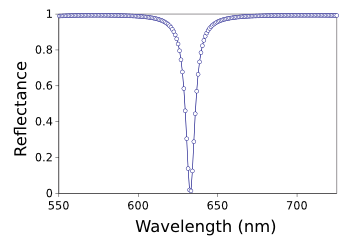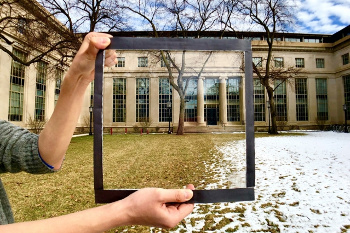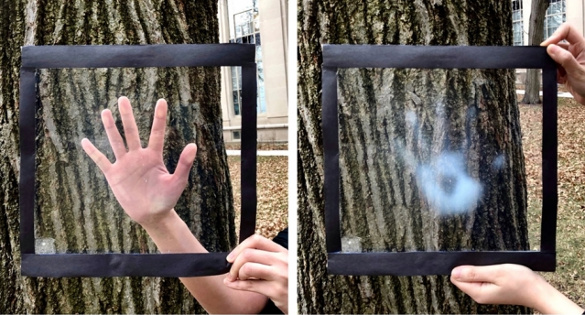Thermal Filtering
January 21, 2019
Modern children would consider my
childhood to have been exceedingly
dull. Our
television could receive just three
channels, there was no
Internet, and you would rarely talk with your friends on the
landline telephone since it was shared by all
family members. It's no wonder that I spent many hours at the
public library, but not all my reading was scholarly.
Joke and
riddle books were popular in that era.
One riddle that demonstrates the
sexism of the
1950s is the following.[1]
A father and son are in an automobile accident that kills the father. The son is brought to the hospital, but the surgeon there says, "I can't operate. This boy is my son!" How is that possible.
The obvious answer is that the surgeon is the boy's
mother, but that answer was elusive at that time since
physicians were nearly all
male. One memorable joke was about the man who invented a device for seeing through
walls - He called it
The Window.

Children find even the simplest things to be funny.
One popular riddle of my childhood was the following: "What's black and white and 'red' all over?
The answer is a newspaper, since the word, read, was heard as red, and newspapers were printed with only black ink in the 1950s.
Words that sound alike, but have different meaning, are called homonyms.
(Created using Inkscape)
Windows cover a large
surface area of most
buildings, so they're a problem for
energy efficiency. They let in too much
sunlight that overly
heats rooms on warmer days, and they let room heat escape on colder days. This is a problem for
homes, but it's a bigger problem for
office buildings. In response to the
1979 oil crisis, my former
employer, who had more than 2,000 people working is such buildings on our
corporate campus, had
window films applied to increase
building insulation. Today, modern windows with low
solar gain are available that block nearly all
solar heat and solar
ultraviolet, while also reducing heat loss in
winter.[2]
My first experience with
thermal filters was when I was doing
darkroom photography when
imaging involved a
chemical process. In those days, an
enlarger was used to project
light through a
photographic negative onto
photosensitive paper to produce a
photograph. Exposure time depended on the
intensity of the light, there were no
white light LEDs at that time, so high
wattage incandescent bulbs were used. To shield the negative from excessive heat, a
dichroic filter was used that passed the visible light but reflected
infrared.
Dichroic filters, along with the complementary
dielectric mirrors, are commonly fabricated by forming a stack of interleaving low and high
refractive index optical materials. Modern
material deposition techniques make it easy to produce such multi-layer optical films. Some of the light traversing the
interface between materials of different refractive index will be
reflected, and the rest will be transmitted.
By selecting the thickness of multiple refractive layers, the reflected rays can be selected to
interfere constructively or destructively at certain
wavelengths. This is an optical manifestation of
Bragg's law. The graph below shows the response of a
bandpass filter for the
helium-neon laser wavelength (632.8
nm) composed of 80 alternating layers of materials with refractive indices of 1.49 and 2.38 having layer thickness of 106.17 nm and 66.47 nm, respectively.

Optical response of a bandpass filter designed for the 632.8 nm helium-neon laser wavelength. This filter has eighty layers of alternating low and high refractive index.
(Graphed using Gnumeric.)
Infrared cut-off filters are useful for more than blocking heat. Since the
silicon imaging chips in
cameras,
tablet computers, and
cellphones respond to infrared light up to a wavelength of about 950 nm, such filters are used to restrict their response to just visible light to give an image that resembles what the
human eye sees. This recalls the interesting story that some people purposely removed such filters in an attempt to "see" through
clothing by imaging the naturally infrared-emitting
human body. You can imagine the poor quality of such images.
Dielectric mirrors can be made as two complementary types, the
cold mirror and the
hot mirror. A cold mirror reflects visible light and transmits infrared light. A hot mirror reflects the infrared and allows visible light to pass through. New
improved efficiency incandescent bulbs have hot mirrors that increase their efficiency by reflecting the infrared back to the
filament to maintain its temperature at a lower
electrical power. Though not as efficient as LED bulbs, they're still
legally sold in the United States while standard incandescent bulbs are not.
The problem with infrared-blocking window films is that they are not perfectly
transparent, since they are too large to be fabricated as dielectric filters. The windows on our corporate campus had a
golden hue from the outside, and obscured the outside view for the building occupants. That's why the
nanophotonics research group of the
Department of Mechanical Engineering at the
Massachusetts Institute of Technology (MIT, Cambridge, Massachusetts) has been working on another sort of heat-blocking window film that's transparent when cold, but
translucent when hot.[3-4]

The MIT window film that blocks up to 70% of solar heat.
Note the excellent transparency to all wavelengths of visible light when the window is cold. It becomes translucent at higher temperatures as the infrared blocking mechanism is activated.[3-4]
That patch of snow coverage is reminiscent of the early snowfall that the US Eastern US endured on November 15, 2018.
(MIT image, also available here.)
Says
Nicholas Fang, a
professor of
mechanical engineering at MIT.
"Smart windows on the market currently are either not very efficient in rejecting heat from the sun, or, like some electrochromic windows, they may need more power to drive them, so you would be paying to basically turn windows opaque. We thought there might be room for new optical materials and coatings, to provide better smart window options."[4]
Scientists from
Hong Kong teamed with Fang's group at MIT on this project, principally because Hong Kong has committed to a reduction in its energy use by 40 percent by the year 2025.[4] Every
square meter of window area in Hong Kong results in an extra 500
watts of energy use.[4]
The active material for these windows is poly (N-isopropylacrylamide)-2-Aminoethylmethacrylate hydrochloride, better written as pNIPAm-AEMA.[3-4] This material exists as transparent
fiber-
webbed spherical hydrogel microparticles filled with water. In early
experiments, this material reflected wavelengths less than infrared since the particle diameter was just 100 nm. Increasing the particle size to 500 nanometers made it effective against solar infrared.[4] A
solution of these microparticles is applied between two sheets of
glass to create an infrared-blocking window.

The heat-rejecting layer becomes translucent when exposed to temperatures above 89°F, as demonstrated by the touch of a human hand. (MIT image, also available here)
The material functions through a change in particle size with temperature, the average size of the microparticles shrinking from 1,388 nm at 25°C to 546 nm at 35°C.[3] At high temperatures, the hydrogel spheres shrink by squeezing out the water, thereby turning the material translucent.[4] Says Fang, "It's like a
fishnet in water... once you squeeze the water out, the fibers become visible."[4]
In
laboratory tests, shining the light from a
solar simulator onto the window showed a rejection of the heat produced by 75.6%.[3] Visible light transmittance at 25°C was 87.2%.[3] A simulated room was cooler by nearly 10°F at a high external insolation when the film was used.[4] This research was partially funded by the MIT-
Hong Kong University of Science and Technology Consortium.[4]
References:
- Rich Barlow, "BU Research: A Riddle Reveals Depth of Gender Bias," Boston University BU Today, January 16, 2014.
- There's an interesting anecdote about radio astronomy pioneer, Grote Reber. In Wikipedia citation needed fashion, it's recalled that his house was so well insulated that use of the kitchen oven would bring the room to 120 °F (50 °C).
- Xin-Hao Li, Chang Liu, Shien-Ping Feng, and Nicholas Xuanlai Fang, "Broadband Light Management with Thermochromic Hydrogel Microparticles for Smart Windows," Joule, November 8, 2018, DOI:https://doi.org/10.1016/j.joule.2018.10.019
- Jennifer Chu, "See-through film rejects 70 percent of incoming solar heat," MIT Press Release, November 8, 2018
Linked Keywords: Modern; child; children; childhood; boredom; dull; television set; television channel; Internet; landline telephone; family; public library; joke; riddle; book; sexism; 1950s; father; son; traffic collision; automobile accident; death; kill; hospital; surgeon; surgery; operate; mother; physician; male; wall; window; humour; funny; newspaper; printing; printed; ink; 1950s; homonym; Inkscape; surface area; building; efficient energy use; energy efficiency; sunlight; heat; room; home; office building; 1979 oil crisis; employer; corporation; corporate; campus; window film; building insulation; solar gain; Sun; solar; ultraviolet; winter; thermal; filter (optics); darkroom; photography; image; imaging; chemical reaction; chemical process; enlarger; light; photographic negative; photosensitivity; photosensitive; paper; photograph; intensity; LED lamp; white light LED; watt; wattage; incandescent light bulb; dichroic filter; infrared; dielectric mirror; refractive index; optics; optical; material; material deposition; interface (matter); reflection (physics); constructive interference; destructive interference; wavelength; Bragg's law; bandpass filter; helium-neon laser; nanometer; nm; Gnumeric; infrared cut-off filter; silicon; image sensor; imaging chip; digital camera; tablet computer; mobile phone; cellphone; human eye; clothing; human body; cold mirror; hot mirror; improved efficiency incandescent bulb; incandescent light filament; electric power; electrical power; phase-out of incandescent light bulbs; legal in the United States; transparent; gold; golden; hue; nanophotonics research group; Department of Mechanical Engineering; Massachusetts Institute of Technology (MIT, Cambridge, Massachusetts); translucent; visible light; snow; snowfall; Eastern United States; Nicholas Fang; professor; mechanical engineering; smart glass; smart window; electrochromism; electrochromic; opacity (optics); opaque; scientist; Hong Kong; square meter; fiber; web; webbed; sphere; spherical; hydrogel; microparticle; experiment; solution; glass; temperatures; Fahrenheit; °F; touch; human hand; fishing net; fishnet; laboratory; solar simulator; Hong Kong University of Science and Technology.